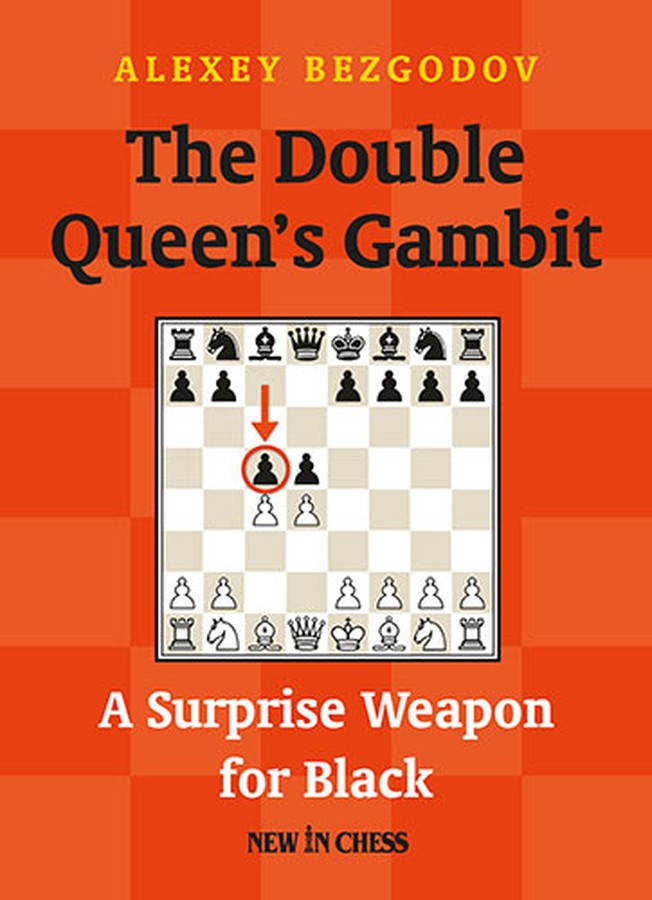| Nivå | B-D |
| Utgivelsesdato | Oktober 2015 |
| Forfatter | |
| Pris | 225 NOK |
The Double Queen's Gambit
A Surprise Weapon for BlackEn stor og seriøs bok om 1 d4 d5 2 c4 c5!?, mye fordi mange stormesterpartier har kommet inn i stillingene i boka fra andre trekkrekkefølger, f.eks. 1 Sf3 d5 2 d4 c5 3 c4 og faktisk også fra Panov-angrepet i Caro-Kann.
Mye tyder på at overraskelsestrekket 2... c5 kan være langt bedre enn vi umiddelbart føler.
Forlagets egen omtale
PDF-utdragAn opening idea that will knock many White players off their feet! Former Russian Chess Champion Alexey Bezgodov provides a complete repertoire for Black against 1.d4, starting with the cheeky move 2…c5! against both 2.c4 and 2.Nf3.
In this opening, the Double Queen’s Gambit, Black’s approach is as active and ambitious as White’s is in the Queen’s Gambit. After thoroughly analysing and investigating, Bezgodov has put the opening to the test in practical grandmaster play. It not only turned out to be playable – it also brought him success, and not just because of its surprise value.
Bezgodov’s conclusion is that there is no clear and compelling way for White to reach an advantage against 2...c5. In The Double Queen’s Gambit he provides dozens of exercises to test your understanding of this surprising chess opening system.
Grandmaster Alexey Bezgodov (1969) was Russian Champion in 1993 and came shared first in the 1999 Ukrainian Championship. He is the author of 'The Extreme Caro-Kann' and 'The Liberated Bishop’s Defence', two highly original chess opening books.
GM Paul van der Sterren in 'Fundamental Chess Openings', on this opening variation: "There is probably a lot to be discovered here and, being as unfashionable as it is, it could well make a wonderful surprise weapon for those who are prepared to put some work into it."
PRAISE FOR ALEXEY BEZGODOV
Aggressive players looking for something fresh and fighting against the Caro-Kann may find this book just what they wanted, while Caro-Kann aficionados may want this book for the purpose of self-defense.
Dennis Monokroussos, The Chess Mind, on 'The Extreme Caro-Kann'...
Truly enriches the world of openings. The reader gets a well-constructed repertoire for Black, which is being presented in a way that is easy to understand.
German Correspondence Chess Federation, on 'The Liberated Bishop’s Defence'...
A very good and honest opening book with serious and deep analysis. The many novelties and new ideas make this system a weapon that one should not underestimate.
Martin Rieger, SchachWelt, on 'The Extreme Caro-Kann'
Innhold
007 Introduction
011 Part I - White avoids the main variations 11
014 Chapter 1: White accepts the gambit
017 Chapter 2: The white bishop comes out
024 Chapter 3: Transposing into the Alapin Variation of the Sicilian
027 Chapter 4: Transposition into the Exchange Variation of the Slav Defence
037 Chapter 5: Transposition into the Panov Attack
049 Part II - Who is tricking whom? 3.Nf3
051 Chapter 6: The rare symmetrical endgame
056 Chapter 7: The mysterious black queen check
066 Chapter 8: The centralised knights system
097 Part III - The queenless DQG: 3.Nf3 cxd4 4.cxd5 Nf6 5.Qxd4 Qxd5 6.Nc3 Qxd4 7.Nxd4
100 Chapter 9: 7...a6 - Taking control of the square b5
129 Chapter 10: 7…Bd7 - The bishop-retention system
143 Chapter 11: 7...e5 - The move of the future?
155 Part IV - The Gorbatov Gambit and the imaginary Semi-Tarrasch: 3.Nc3
157 Chapter 12: A fascinating gambit
163 Chapter 13: The classical 3...Nf6
177 Part V - The Deferred Capture Variation: 3.cxd5 Nf6
179 Chapter 14: White takes on c5
187 Chapter 15: The strong 4.e4
193 Chapter 16: An Attempt at Revival
205 Part VI - The main variation: 3.cxd5 Qxd5
208 Chapter 17: Early divergences
217 Chapter 18: The Queen Retreats 5...Qd7/5...Qd8
223 Chapter 19: Minor white moves after 6...Nf6
233 Chapter 20: The fianchetto 7.g3
247 Part VII - Retro-Training
278 Postscript
279 Bibliography
281 Index of Variations
285 Index of Games
| Innbundet? | Nei |
| Type | Bok |
| Språk | Engelsk |
| Antall sider | 288 |

